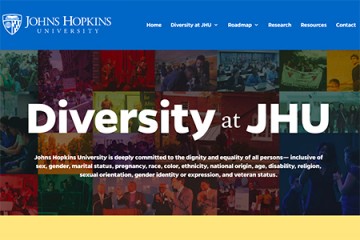Building upon recent efforts to report regularly on the gender, ethnic, and racial composition of faculty and graduate students, Johns Hopkins University is publishing its first Report on Staff Composition. University leaders say it is intended to uphold the commitment to transparency and accountability expressed in the Roadmap on Diversity and Inclusion and offer a baseline from which to measure progress.
"Measuring our workforce demographics and workplace climate is vital to achieving our shared goal of attracting, retaining, and advancing a diverse workforce at all levels, while promoting an environment in which all staff members feel included and engaged in the success of our enterprise," said Heidi Conway, vice president for Human Resources, and Fenimore Fisher, vice provost and chief diversity officer, in a message to the university community today. "We and other members of our community—including leaders of the Diversity Leadership Council and Black Faculty and Staff Association—have worked to strengthen the collection of data that paints a clearer picture of our staff workforce."
Quantitative baseline and trend data in the staff composition report is supplemented by a qualitative assessment collected from more than 7,000 staff participants in the 2018 Gallup employee engagement survey. That survey included 12 standard questions and, for the first time, included additional questions on diversity and inclusion. All results were disaggregated by gender, race, ethnicity, and LGBTQ identity.
"Together these data offer a more vivid and comprehensive picture of our staff workforce and provide a foundational understanding that will help us shape new and ongoing initiatives in ways that support our aims," Conway and Fisher said.
According to the composition report:
- 39% of university staff identified as racial or ethnic minorities (black or African American, Asian, Hispanic, American Indian, Hawaiian or other Pacific Islander), up slightly from 35% in 2013 and 2015.
- The highest minority representation was found in the service (84%), administrative support (47%), and tech/paraprofessional (47%) employee groups, while the executive/administrative (21%) and managerial (24%) employee groups featured the lowest minority representation.
- 71% of university staff identified as female, relatively consistent with 2013 and 2015 data.
- The highest female representation was found in the administrative support (89%) and professional (70%) employee groups, while the service (39%) and skilled crafts (1%) employee groups featured the lowest female representation.
In 2018, Johns Hopkins' overall employee engagement score—which refers to employees' involvement in, commitment to, and enthusiasm for their work and workplace—increased from 3.80 out of five total points in 2015 to 3.88 in 2018. However, the engagement scores of black and Hispanic staff (3.80 and 3.86, respectively) were lower than that of white staff (3.91). Conway and Fisher said these points and other data in the report affirm anecdotal feedback that they have received from staff affinity groups over time and serve as a renewed call to action.
In spring 2019, the university established a Staff Diversity Initiative working group with representation from staff, the university HR leadership team, the Office of Diversity and Inclusion, deans, divisional business officers, and university leadership. The group is charged with identifying opportunities, developing recommendations, and prioritizing key performance indicators to support initiatives that promote staff diversity and inclusion.
In addition to universitywide efforts, each division is using its results to guide diversity efforts that engage faculty, students, and staff. At the School of Nursing, for example, leaders responded to survey results with a renewed focus on diversity in recruitment and will shortly launch a structured mentoring and peer-learning program.
"Our most recent Gallup data disaggregated by gender, race, and ethnicity has provided a critical insight into areas requiring a renewed focus and increased attention," said Dean Patricia Davidson. "We look forward to the next reporting period to review the impact of our tailored and targeted strategies."
Posted in University News, News+Info
Tagged diversity










